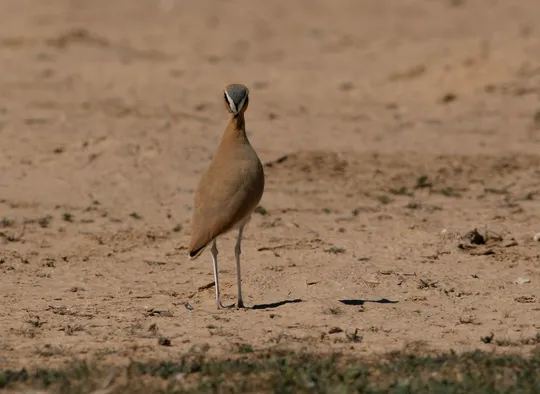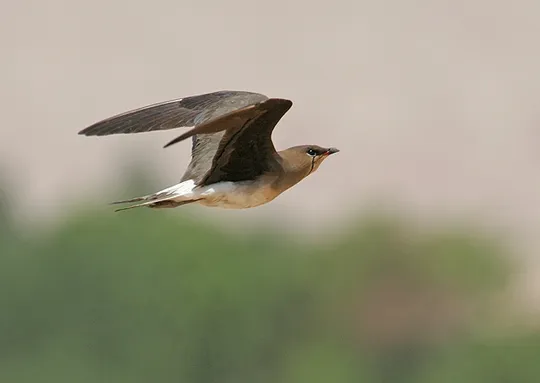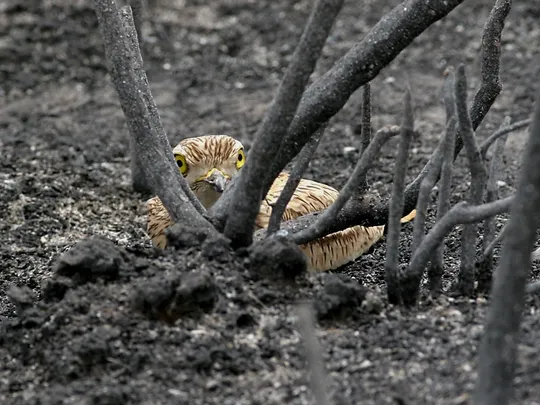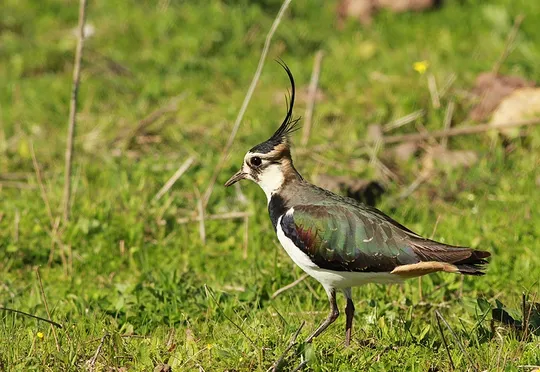Glareola pratincola
 Endangered
Endangered
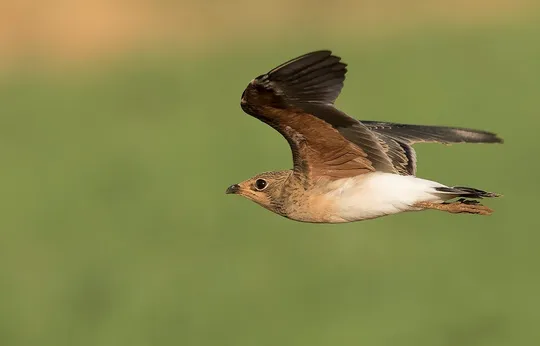
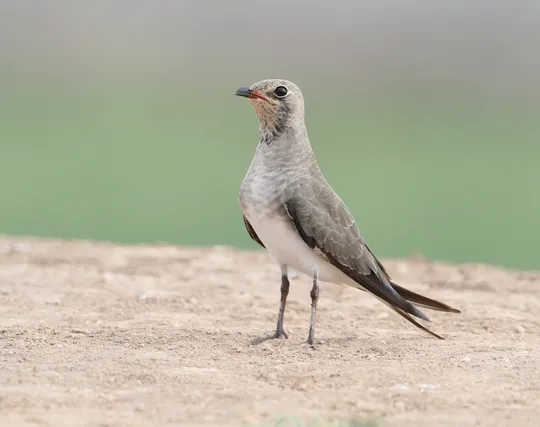
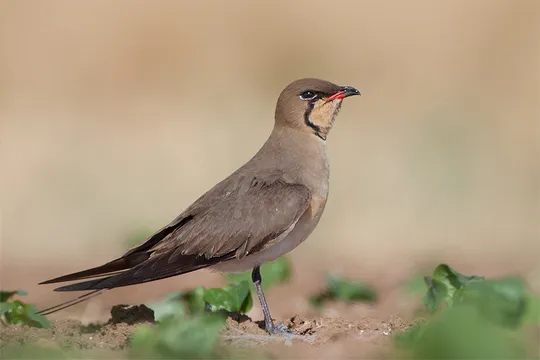
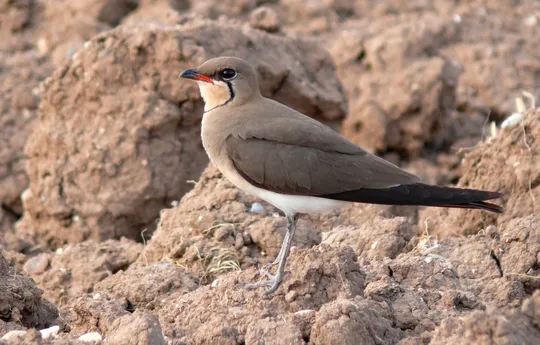
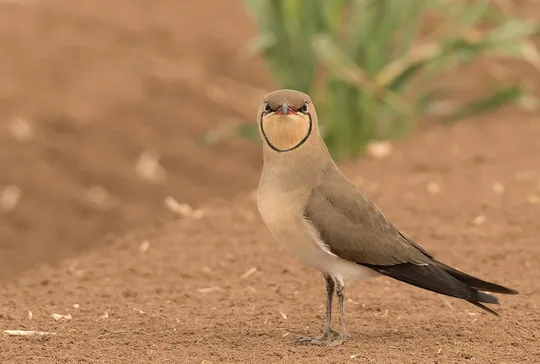
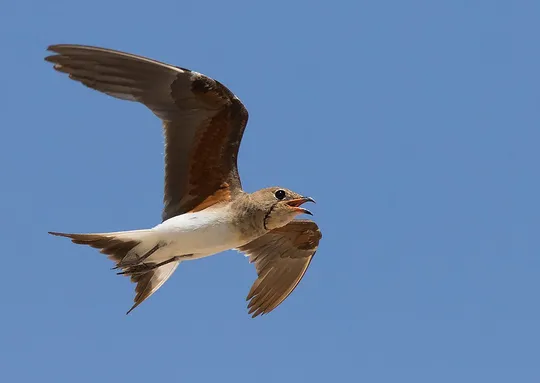
| Habitats | Cropland, Humid Lowlands |
|---|---|
| Presence In Israel | Summer, Migrant |
| Breeding In Israel | Breeder |
| Migration Types | Long Range |
| Zoographical Zones | Mediterranean, Irano-Turanian |
| Landscape Types | Plains & Valleys, Rural Area |
| Vegetation Types | Cropland |
| Vegetation Densities | Low |
| Nest Locations | Ground |
| Diet Types | Invertebrate |
| Foraging Grounds | Aerial |
| Body Sizes | Small (up to 500g) |
| Threat Factors | Pesticide Poisoning, Nest destruction by agricultural activity, Increased predation from invasive and eruptive species |
The Collared Pratincole is a slender short-legged wader, with long wings, a forked tail and light floating flight reminiscent of tern flight. It is a gregarious bird that forms small flocks and feeds on insects it catches mainly in the air.
The Collared Pratincole is a rare summer breeder and a relatively common passage migrant. The present breeding population is relictual and fragmented, found in small colonies in the Hula Valley (20-30 pairs), the southern Golan Heights (5-10 pairs), the Bet She’an Valley (5-10 pairs) (Cabara et al. 2013, 2014), and occasionally in the Judean Lowlands as well (up to 5 pairs, Ezra Hada pers. comm.). It nests mainly in agricultural fields and therefore is very sensitive to cultivation methods. In the Hula Valley, there is an ongoing preservation project with local farmers. In the past it was a common summer breeder and hundreds of pairs nested in the northern and eastern valleys and on the Coastal Plain. In the 1950s, the population began to decrease sharply and by the late 1980s the species was almost completely extirpated from Israel.
The Collared Pratincole nests mainly in cultivated fields with low vegetation or in trampled grazing areas and near water bodies. Pratincoles can be seen throughout Israel during migration, in agricultural fields and near ponds and reservoirs.
Pesticides – the Collared Pratincole was severely impacted by the intensive use of insecticides, which is apparently the main reason for the sharp decline during the 1960s and 1970s.
Direct disturbance – Collared Pratincoles nest in active agricultural fields in which crops such as peanuts, corn and cotton are in their early germination stages, when there is intensive farming management that affects their breeding success.
Eruptive species – predation pressure has increased, resulting from the proliferation of eruptive predatory species such as crows, jackals and boars.
Collared Pratincole breeding colonies in the Hula Valley are monitored annually together with local farmers. Efforts are made to protect the nests and chicks.
The Collared Pratincole is a migratory species that was affected in the past by the uncontrolled use of agricultural pesticides. The present population in Israel is very small,
inhabits only a fraction of its past range. Most of the breeding colonies are in agricultural areas and susceptible to harm from cultivation. The major threat facing the species is cultivation that adversely affects nesting success.
- ישראלי, נ., לבינגר, ז., אורון, ט. והצופה, א. 2011. מיזם הגנה על קינון שדמית אדומת כנף בצפון הארץ. דו"ח לקרן דוכיפת.
- כברה, ל. 2013. קינון שדמית אדומת כנף בעמק החולה - סיכום עונת מחקר ראשונה.
- פז, ע. 1986. עופות. מתוך אלון, ע. (עורך), החי והצומח של ארץ ישראל. כרך 6. הוצאת משרד הביטחון, ישראל.
- Symes, A. 2013. Species generation lengths. Unpublished, BirdLife International.
- Species page at Birdlife International
Current Occupancy Map
| Data Missing | Sporadic | Limited Sites | Low Density | High Density |
|---|---|---|---|---|
| 0 | 0 | 0 | 0 | 0 |
Distribution maps
The maps presented here provide visual information on the distribution of species in Israel from the past and present, and the changes in occupancy and breeding density during the comparison period. For further reading
Relative Abundance 2010-2020
Breeding density values in the current decade as determined from experts' opinion and observations from databases.
| Data Missing | Sporadic | Limited Sites | Low Density | High Density |
|---|---|---|---|---|
| 8 | 12 | 12 | 21 | 19 |
Relative Abundance 1980-1990
Density values based primarily on the book The Birds of Israel (Shirihai 1996).
| Data Missing | Sporadic | Limited Sites | Low Density | High Density |
|---|---|---|---|---|
| 5 | 14 | 14 | 17 | 22 |
Occupancy 1990-2020
The map shows differences in the species breeding distribution between the 1980's breeding map and the current weighted breeding evaluation. Negative value - species previously bred in the grid and is not presently breeding; positive value - species has not previously bred in the grid and is currently breeding.
| Data Missing | No Change | Occupancy Increase | Occupancy Decrease |
|---|---|---|---|
| 6 | 35 | 1 | 9 |
Change in Relative Abundance 1990-2020
The map shows the changes in the relative abundance of a species in each of the distribution grids between the breeding map of the 1980s and the weighted current breeding evaluation. Negative values - decline in abundance; positive values - increase in abundance; zero - no change in abundance.
| 80 to 100 | 50 | 20 to 30 | No Change | 30- to 20- | 50- | 100- to 80- | Data Missing |
|---|---|---|---|---|---|---|---|
| 0 | 4 | 2 | 22 | 12 | 14 | 11 | 16 |
| Rarity | |
|---|---|
| Vulnerability | |
| Attractiveness | |
| Endemism | |
| Red number | |
| Peripherality | |
| IUCN category | |
| Threat Definition according to the red book |
 Contributed:
Contributed: 